July 1998–September 2000

#1. Project description
In public procurement the tendency is to award contracts to contractors who then sub-contract the work in parts to small suppliers whilst taking the profit.SUPPLYPOINT is a system which provides an integrated business service that supports the formation and operation of virtual supply chains. It allows SMEs to directly take advantage of procurement opportunities, to take on large contracts jointly, to ensure timely and cost effective delivery and to resolvesupply problems dynamically. The service integrates existing electronic procurement services, provide EDI capability, use multimedia and interactive WWW technologies, includes tools for virtual marketplace design and management,electronic payments, advanced document handling and decision support for legal requirements.
The project partners were:
- University of Sunderland (UK)
- TradeZone International (UK)
- Institut Fur Arbeitswissenschaft und Technologiemanagement (D)
- NetGuide (DK)
- Institute of Communication & Computer Systems (GR)
- Lancexport (FR)
- ISKV (FR)
##Main concepts ofthe SupplyPoint Solution
SupplyPoint provides an environment, where small and medium-sized enterprises (SMEs) canreadily create supply chains and be supported throughout the life cycle of abid, from contract identification to contract award.
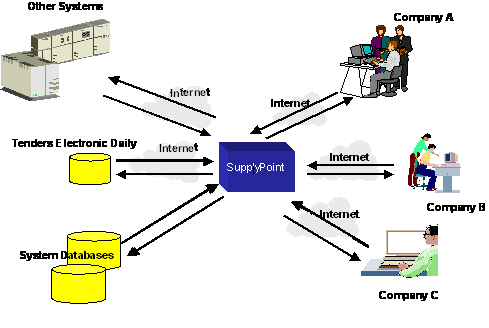
Assume e.g.that Company A wishes to search for tenders and connects to the system through the Internet. The search for tenders can take place either directly byconnecting to TED, or by entering other systems that publish tenders, using abrowser. Search results are stored in the databases of SupplyPoint. Company Acan now search, using SupplyPoint, for partners (Company B), and establishcommunication with them, resulting in the formation of a virtual consortium.Consecutively, Companies A and B use the electronic space provided to them bySupplyPoint and prepare the bid to the selected tender. In this context, theylocate Company C that will provide them with the necessary material, andinvitations to bid and requests for quotations are made.
##Rooms
A basic concept of SupplyPoint is the concept of Rooms. A “Room-based” interface has beenused by several systems to allow people work together more naturally. Itprovides the users with a readily comprehensive metaphor for their “location”within the SupplyPoint system.
A Room is a place in the system, where information(documents) and users that have access to those documents are stored. Rooms cancontain other rooms and documents in a hierarchical manner analogous to mostcomputer directory tree structures. Similarly each room has rights forvisibility and access. Again, documents have rights for view, edit and delete.A top level Room is automatically created when an organization is registered toSupplyPoint. This is the “Home Room” of the organization. Users can create (andsubsequently edit and delete) new Rooms and store information (e.g. contractsand potential partners) concerning the formation of Virtual Consortia. They can also add, edit, view and remove both documents and user access from the Rooms.
Each entity(a subscribing organisation or a virtual consortium) in the system owns a toplevel „Home Room“, which by default contains two sub rooms: “Bookmarked Organisations”and “Bookmarked Contracts”. These Rooms help to organise information thatconcerns contracts and organisations and will be used for the formation of aVirtual Consortium.
##Functional Structure
The SupplyPoint system consists of nine concrete, autonomous subsystems:
- the document management subsystem, which provides a flexible environment for creation, editing, exchanging and deleting of documents;
- the workflow management subsystem, supporting the automation of workflows for the formation of the virtual consortium and the preparation of the bid;
- the subsystem for the management of the electronic payments of the users’ fees;
- the subsystem for the management of searches, including the criteria-based search for tenders as well as the search for potential partners using the profiles of the companies registered to SupplyPoint;
- the administration subsystem, which gives users the possibility to add other users and change the company’s working and interest profile;
- the graphical user interface (GUI) that connects the user to the system;
- the help subsystem, providing technical and functional help to the users;
- the communication subsystem, which on the one hand connects with databases and systems containing information useful to the users (TED, ELPRO) and on the other hand supports the communication between users and companies-members of the virtual consortia;
- the access control subsystem, concerning the registration to the system and the user authentication prior to having the desirable information available.
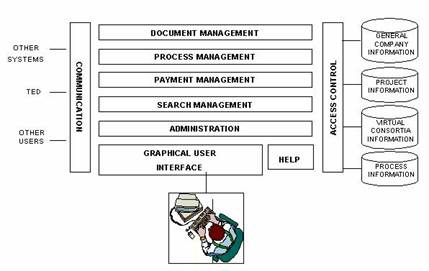
##SupplyPoint Architecture
The following figure shows the main components of the SupplyPoint (SPP)architecture. The system consists oftwo main parts, the SPPClient and the SPPServer. It also allows for integration with externalsystems (ELPRO is shown as an example).
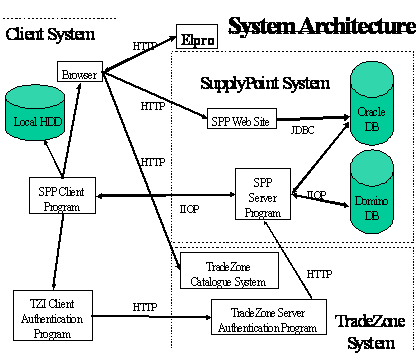
It should be noted that the Common Object Request Broker Architecture (CORBA) is used toprovide a communications protocol. TheSPPClient establishes a connection with the SPPServer via the “InternetInter-Orb Protocol” (IIOP). The LotusNotes Domino Server is used to provide the basic workflow components andinfrastructure. The visual element ismirrored in the client using a Java Graphical User Interface(GUI), thus providing a high degree of integration.
The SPPClientdelivers services to the users of the SupplyPoint system. It provides a Graphical User Interfacedeveloped in Java 1.2 that allows the user to access the required functionalityfrom almost any workstation. Within the SPPClient the user is able tocommunicate with other SupplyPoint system users via a communication/E-mailsystem developed (or rather integrated) for that purpose. The Rooms concept (see Section 7) provides the users with a readily comprehensible metaphor fortheir “location” within the SupplyPoint system. Both documents and users are associated with Rooms. The GUI representing the notion of rooms is atree view similar to windows explorer.
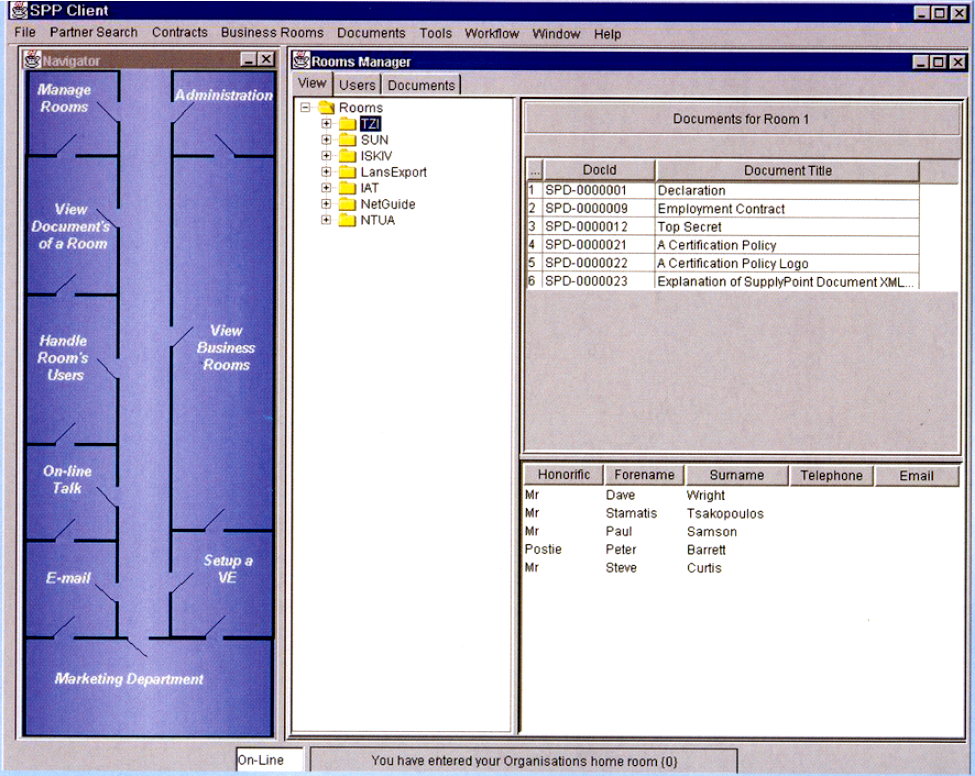
Using the SPPClient, the user is able to handle documents belonging to those roomsdepending on the permissions that have been set for the specific documents /rooms. A number of external facilities are also accessible via the SPPClientincluding: an Electronic catalogue that enables them to purchase through the world wide web and anelectronic procurement system that enables users to look for availablecontracts on the web and prepare tenders.
The SPPClient is installed on the user’s machine but it invokes methods, throughIIOP, that are implemented on the SPPServer. This thin client approach has beenfollowed in the SupplyPoint system, thus offering a minimal footprint for theclient program and reducing the computing requirement on the company’s computersystem.
The serverprovides all the functionality for querying, inserting and updating the databasefor permissions, documents, user details, etc. The SPPServer connects tothe Oracle database via a Thin JDBC driver in order to be able to query thedatabase. Requests from the SPPClientare received via the IIOP and the SPPServer executes a specific method relatedto the request and queries the database via the JDBC driver.
Asindicated, the connection between the SPPServer and the SPPClient is via IIOPfor CORBA objects, however in order to provide support for workflow andauthentication, an XML wrapping technique for documents is used.
The SPPServer provides an Administration tool in order to be able set-up new usersand organisations in the system. It canalso monitor the database and the system logs. The required configuration toolsare also available to initialise the SupplyPoint system properties such as theORB and the database connection.
##UseCase: Forming Virtual Consortia
The formation of virtual consortia within the SupplyPoint system involves the direct interactionand communication between potential partners, who enter into discussions,through the system, to form a collaboration to deal with a specifictender/project.
An organisation can identify potential partnersusing various searches or through suppliers/partners already known to them(bookmarked). Discussions with thesepotential partners can be carried out and agreements made, to form a virtualconsortium by creating a shared work area containing various collaborationsections.
Within this on-line business area, or virtualcompany building, the partners are given access to discussion rooms, datastorage rooms and workflow procedures, to facilitate the collaborativeprocesses to prepare and submit a bid for tender.
Before actually forming a VC, the interestedparty should have selected partners and documents needed for the bid, andcollected all that information in a Room (using the “Drag and Drop”functionality of SupplyPoint). This initial Room represents the first stage ofthe setting up of the VC. The agreements with the partners are not yetfinalized and it is possible that some partnerships will fall apart, while newones will be created.
The communication with the potential partnersis supported by the Workflow subsystem of SupplyPoint. Initially, a messageserving as an invitation to partnership can be composed. The actual partnershipinvitation, as well as all the necessary information concerning the desiredcontract can come as an attachment to the message. The potential partner willreceive notification in his mail. After evaluating the invitation, he willcommunicate a positive or negative response to it. Lack of answer, is also a possible outcome.
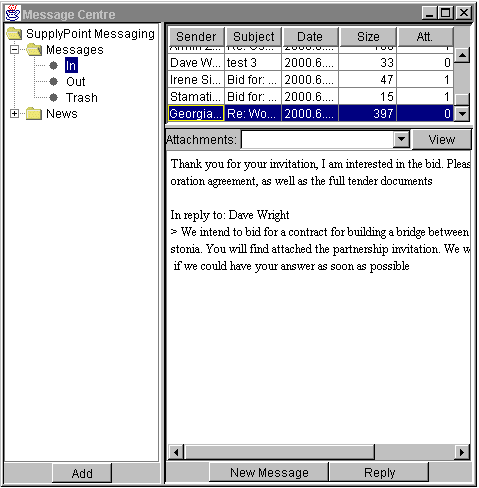
This process may need to be repeated several times, to communicate with all potential partners. Once the contact phase withall prospective partners is over, the virtual consortium can actually beformed.
The Setup VC component of SupplyPoint represents the final stage of the VC formation. All the system Rooms can bebrowsed and the one that contains all the relevant information (documents andusers) for the VC is selected. The Room name appears in the Setup VC component,as well as its documents and users. The documents and users that will, from nowon, belong to the VC are selected and transferred to the Room of the VC. Byclicking the “Setup VC” button, the VC “Room” is created.
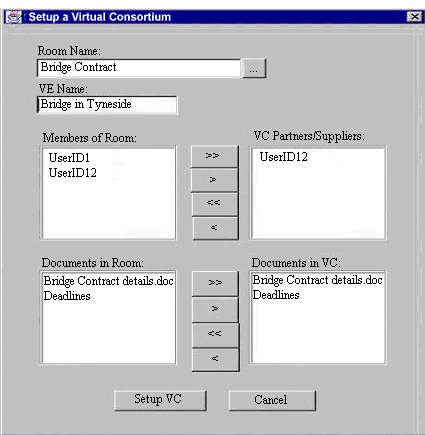
Once formed, the VC can do anything that asingle company can do within the SupplyPoint system. However, internal workflow will be requiredto ensure that all relevant parties have agreed on a particular action. Forexample, the partners must electronically agree any tender documents beforethey can be submitted as a bid. Toprepare a bid, a workflow procedure is used allowing all partners to contributeand agree to the bid before it is sent to the awarding body. These processes are supported by theworkflow facilities of SupplyPoint.
#2. Related publications
- Mentzas, G. and G. Bafoutsou (2004) Electronic Collaboration, Communication and Cooperation: A Taxonomyand a Prototype, Chapter II in E. Y. Li and T. C. Du (eds) Advances inElectronic Business, Vol. 1, Theme: "Collaborative Commerce",Idea Group Publishing, pp. 19-52.
- Halaris, C., S. Kerridge, G. Bafoutsou, G.Mentzas and S. Kerridge (2003) An Integrated SystemSupporting Virtual Consortia in the Construction Sector, Journal ofOrganizational Computing and Electronic Commerce, Vol. 13, No 3 & 4,pp. 243-265.
- Bafoutsou, G. and G. Mentzas (2002) Review and functional classification of collaborative systems, InternationalJournal of Information Management, Volume 22, Issue 4, August 2002, pp.281-305.
- Kerridge, S., C. Halaris, G. Bafoutsou, G.Mentzas (2001) Supplypoint: Virtual ConsortiumFormation in the Construction Sector, IBIC 2001 – Internet Business and the Industry ofConstruction, Portugal,2001.
- Halaris, C. G. Bafoutsou, G. Papavassiliouand G. Mentzas (2001) Virtual Tendering and Bidding in theConstruction Sector. Presented in the 8th Panhellenic Conference onInformatics, Nicosia, Cyprus, November 8-10, 2001.
- Kerridge, S. C. Halaris, G.N. Mentzas, S.Kerridge (2000) Virtual Tendering and Bidding inthe Construction Sector, Published in Lecture Notes in Computer Science1875: Electronic Commerce and Web Technologies, December 2000 (Vol 1875, pp379-388). ISBN: 3540679812

